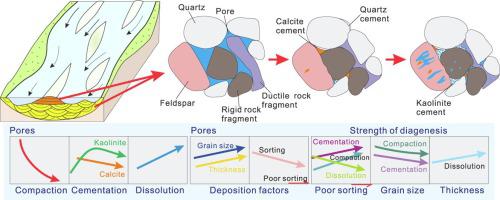Journal of Asian Earth Sciences ( IF 2.7 ) Pub Date : 2021-03-19 , DOI: 10.1016/j.jseaes.2021.104745 Jian Li , Xiang Zhang , Jingchun Tian , Qingshao Liang , Tongsheng Cao

|
The impacts of deposition and diagenesis on sandstone reservoir quality have been extensively discussed over the years. But the research on how depositional factors control the reservoir quality by affecting diagenesis is rarely involved. The Permian System in the northern Ordos Basin is composed of clastic rocks, and sandstones formed in a braided river sedimentary system (braided channel and braided bar) are one of the most important reservoirs. Sandstones formed in the braided channel have inferior sorting, thinner depositional thicknesses, and higher contents of rock fragments and calcite cement. The total thin-section porosity, porosity and permeability of the sandstones are 5.9%, 9.76% and 0.75 × 10−3 μm2, respectively. The grain size and sedimentary thickness are positively correlated with the reservoir quality, and the secondary pores of the well-sorted sandstone are more developed. Sedimentary compaction resulted in average reductions of 85.69% and 82.76% in sandstones formed in the braided channel and braided bar, respectively. An appropriate amount of kaolinite (<6%) was conducive to the development of reservoir quality. Calcite cements have reduced the pore spaces, whereas quartz cements do not have a major control on the reservoir quality. Diagenesis directly impacts reservoir quality, whereas depositional factors determine the preference and strength of diagenesis. The strength of dissolution is greater in the well-sorted sandstone, and the poorer the sorting, the greater the compaction index and cementation. The grain size, sorting, and deposition thickness control the sandstone reservoir quality by affecting the compaction strength, cement content, and dissolution.
中文翻译:

沉积和成岩作用对砂岩储层质量的影响:以鄂尔多斯盆地北部辫状河沉积体系中形成的二叠系砂岩为例
多年来,已经广泛讨论了沉积和成岩作用对砂岩储层质量的影响。但是很少涉及沉积因素如何通过影响成岩作用来控制储层质量的研究。鄂尔多斯盆地北部的二叠系由碎屑岩组成,在辫状河沉积系统(辫状河道和辫状条)中形成的砂岩是最重要的储层之一。辫状河道中形成的砂岩分类较差,沉积厚度较薄,碎石和方解石水泥的含量较高。总薄片孔隙度,孔隙率和砂岩的渗透性是5.9%,9.76%和0.75×10 -3微米2, 分别。粒度和沉积厚度与储层质量成正相关,且分类良好的砂岩的次生孔隙更加发育。沉积压实作用使辫状河道和辫状条形成的砂岩平均减少了85.69%和82.76%。适量的高岭石(<6%)有利于储层质量的发展。方解石水泥减少了孔隙空间,而石英水泥对储层质量没有重大控制。成岩作用直接影响储层质量,而沉积因素决定成岩作用的优先次序和强度。在分类良好的砂岩中,溶解强度越大,分类越差,压实指数和胶结作用越大。粒度,分选,











































 京公网安备 11010802027423号
京公网安备 11010802027423号